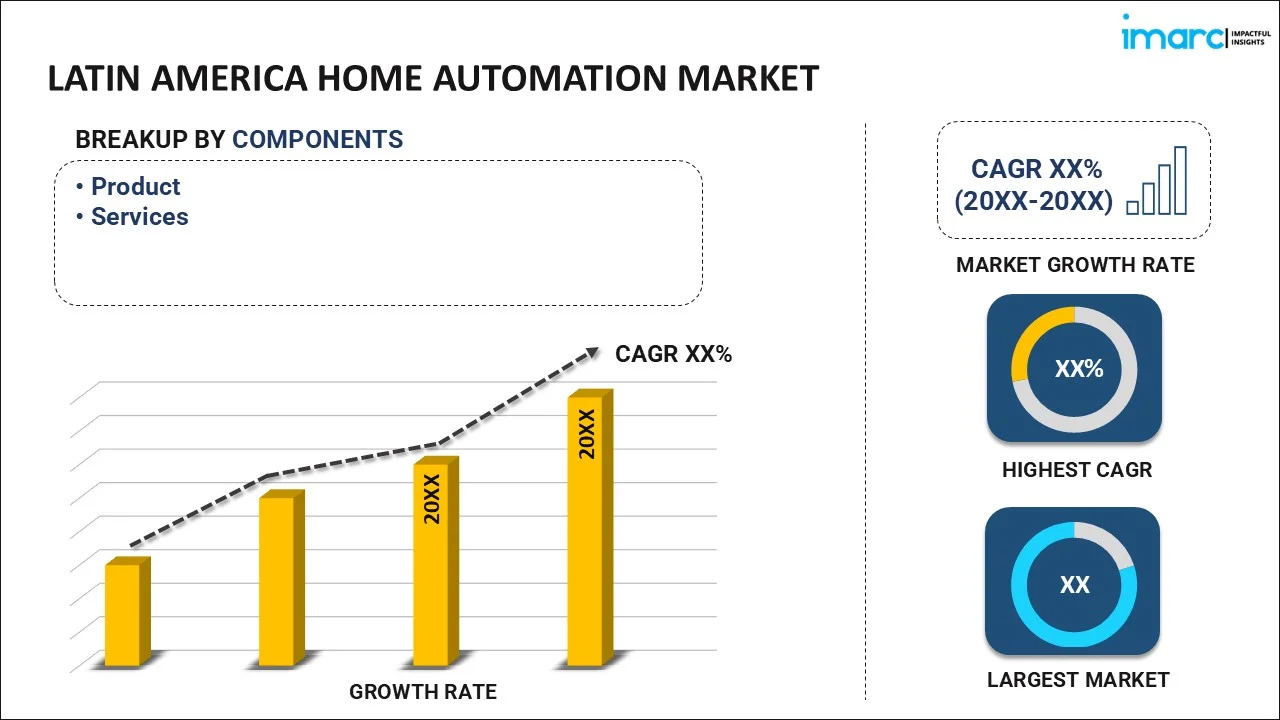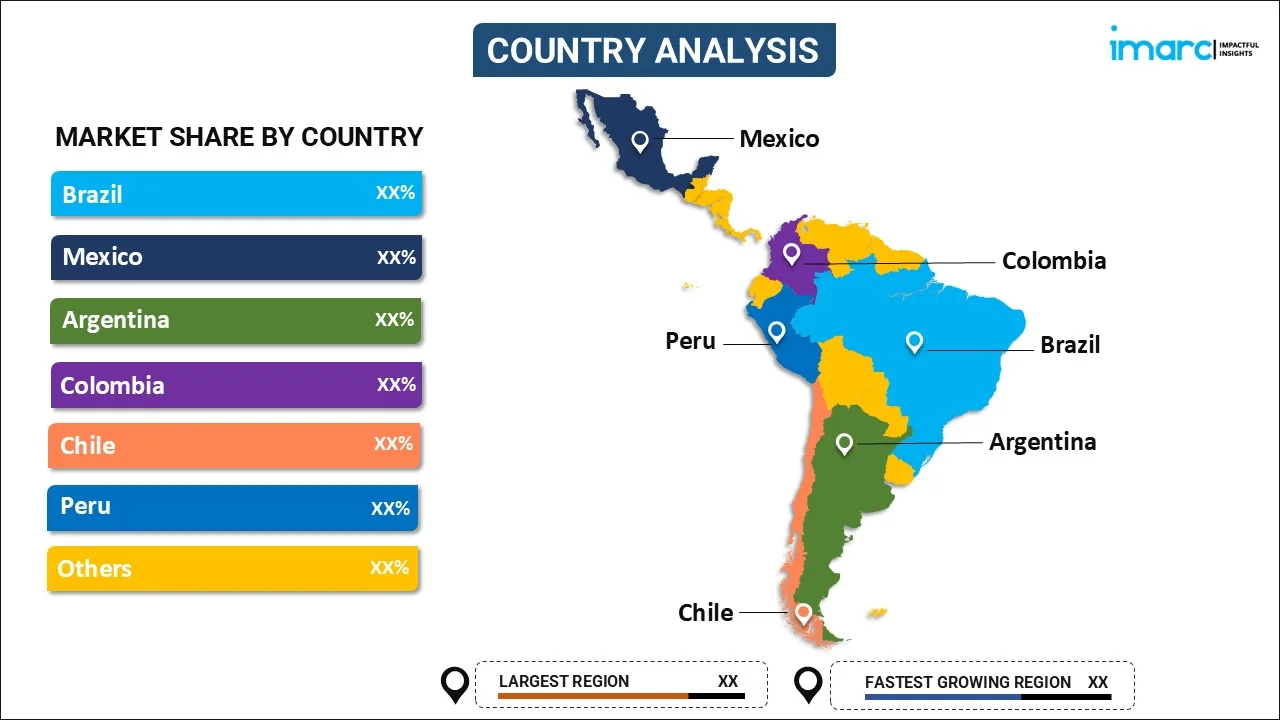
Latin America Home Automation Market Size, Share, Trends and Forecast by Component, Network Technology, and Country, 2025-2033
Latin America Home Automation Market Overview:
The Latin America home automation market size reached USD 5.27 Billion in 2024. Looking forward, IMARC Group expects the market to reach USD 9.72 Billion by 2033, exhibiting a growth rate (CAGR) of 7.03% during 2025-2033. The market is expanding rapidly, driven by rising consumer interest in smart home technologies, energy efficiency, and enhanced security. Moreover, increasing internet penetration and affordable smart devices further support adoption across residential spaces, fueling Latin America home automation market growth throughout the region.
|
Report Attribute
|
Key Statistics
|
|---|---|
|
Base Year
|
2024 |
|
Forecast Years
|
2025-2033
|
|
Historical Years
|
2019-2024
|
| Market Size in 2024 | USD 5.27 Billion |
| Market Forecast in 2033 | USD 9.72 Billion |
| Market Growth Rate (2025-2033) | 7.03% |
Latin America Home Automation Market Trends:
Magnifying Demand for Smart Security Solutions
Latin American consumers have shown an increased focus on security, resulting in greater demand for home automation systems that address safety concerns. Surveillance cameras, motion sensors, and remote locks are becoming increasingly popular, allowing homeowners to monitor and secure their homes from anywhere. Moreover, rising crime rates in certain neighborhoods only exacerbate this trend. As per industry reports, Venezuela currently holds the highest homicide rate in Latin America at 45.6 per 100,000 citizens, ranking among the highest globally. Additionally, the affordability and accessibility of smart security systems, combined with easy smartphone integration, make these solutions appealing across income levels, thereby expanding the market’s reach and adoption rate.
Rising Adoption of Energy-Efficient Smart Devices
The rise in demand for energy-efficient smart home devices as consumers become more environmentally conscious and seek cost-saving solutions is creating a positive Latin America home automation market outlook. The Internet of Things smart tech also has a role to play, the popularity of smart thermostats, energy-efficient lighting, or automated energy management systems that offer users better control of energy consumption, resulting in lower utility bills. Additionally, the increasing electricity consumption by the residential sector increases the demand for efficient technologies, therefore increasing its adoption. According to the International Energy Agency, in 2023, the residential sector accounted for 29% of the total final electricity consumption in Brazil. Additionally, this trend is reinforced by government programs that encourage energy efficiency as well as a growing focus on sustainable living initiatives. With the continuous development of smart technology, consumers are learning that they can easily bring these devices into their daily lives, and automated energy efficiency has therefore become one of the key terms in the market.
Rapid Expansion of Voice-Controlled Home Automation
Voice-controlled devices, such as smart speakers and digital assistants, are rapidly gaining popularity in Latin American households as they simplify home automation. For instance, as per industry reports, in 2023, 70% of individuals in Brazil owned an Amazon Echo, a leading smart speaker brand. The convenience of voice commands allows users to control various functions, from lighting to climate settings, with minimal effort. In addition to this, easy integration with existing smart devices, coupled with increasing bilingual support, has made voice-activated technology more accessible and user-friendly. This trend is further bolstered by affordable options from global tech leaders, making voice-controlled automation a practical choice for homeowners across different income levels and contributing to the Latin America home automation market share.
Latin America Home Automation Market Segmentation:
IMARC Group provides an analysis of the key trends in each segment of the market, along with forecasts at the regional level for 2025-2033. Our report has categorized the market based on component and network technology.
Component Insights:

- Product
- Security and Safety
- HVAC
- Wellness Monitoring
- Smart Appliances
- Smart Entertainment
- Smart Lighting
- Others
- Services
- Consulting
- Installation and Implementation
- Support and Maintenance
The report has provided a detailed breakup and analysis of the market based on the component. This includes product (security and safety, HVAC, wellness monitoring, smart appliances, smart entertainment, smart lighting, and others), and services (consulting, installation and implementation, and support and maintenance).
Network Technology Insights:
- Wired
- Wireless
- Power Line-Based
A detailed breakup and analysis of the market based on network technology have also been provided in the report. This includes wired, wireless, and power line-based.
Country Insights:

- Brazil
- Mexico
- Argentina
- Colombia
- Chile
- Peru
- Others
The report has also provided a comprehensive analysis of all the major regional markets, which include Brazil, Mexico, Argentina, Colombia, Chile, Peru, and others.
Competitive Landscape:
The market research report has also provided a comprehensive analysis of the competitive landscape. Competitive analysis such as market structure, key player positioning, top winning strategies, competitive dashboard, and company evaluation quadrant has been covered in the report. Also, detailed profiles of all major companies have been provided.
Latin America Home Automation Market News:
- In July 2024, Ecozy debuted its smart home kitchen lineup at the Latin American Electronics International Trade Show, marking its entry into the Brazilian market. The showcase includes AI-driven products including smart air fryers, dishwashers, and coffee machines with app control, aligning with Latin America's growing demand for advanced, affordable home automation solutions.
- In March 2024, Samsung’s SmartThings platform announced the expansion of its partnership with Philips Hue, a global leader in smart lighting, to advance home automation and transform user interaction with home entertainment systems. This collaboration introduced exclusive updates for enhanced control of the Philips Hue Sync TV App via SmartThings, available for sale in additional markets, including Brazil.
Latin America Home Automation Market Report Coverage:
| Report Features | Details |
|---|---|
| Base Year of the Analysis | 2024 |
| Historical Period | 2019-2024 |
| Forecast Period | 2025-2033 |
| Units | Billion USD |
| Scope of the Report |
Exploration of Historical Trends and Market Outlook, Industry Catalysts and Challenges, Segment-Wise Historical and Future Market Assessment:
|
| Components Covered |
|
| Network Technologies Covered | Wired, Wireless, Power Line-Based |
| Countries Covered | Brazil, Mexico, Argentina, Colombia, Chile, Peru, Others |
| Customization Scope | 10% Free Customization |
| Post-Sale Analyst Support | 10-12 Weeks |
| Delivery Format | PDF and Excel through Email (We can also provide the editable version of the report in PPT/Word format on special request) |
Key Questions Answered in This Report:
- How has the Latin America home automation market performed so far and how will it perform in the coming years?
- What is the breakup of the Latin America home automation market on the basis of component?
- What is the breakup of the Latin America home automation market on the basis of network technology?
- What is the breakup of the Latin America home automation market on the basis of country?
- What are the various stages in the value chain of the Latin America home automation market?
- What are the key driving factors and challenges in the Latin America home automation market?
- What is the structure of the Latin America home automation market and who are the key players?
- What is the degree of competition in the Latin America home automation market?
Key Benefits for Stakeholders:
- IMARC’s industry report offers a comprehensive quantitative analysis of various market segments, historical and current market trends, market forecasts, and dynamics of the Latin America home automation market from 2019-2033.
- The research report provides the latest information on the market drivers, challenges, and opportunities in the Latin America home automation market.
- Porter's five forces analysis assist stakeholders in assessing the impact of new entrants, competitive rivalry, supplier power, buyer power, and the threat of substitution. It helps stakeholders to analyze the level of competition within the Latin America home automation industry and its attractiveness.
- Competitive landscape allows stakeholders to understand their competitive environment and provides an insight into the current positions of key players in the market.
Need more help?
- Speak to our experienced analysts for insights on the current market scenarios.
- Include additional segments and countries to customize the report as per your requirement.
- Gain an unparalleled competitive advantage in your domain by understanding how to utilize the report and positively impacting your operations and revenue.
- For further assistance, please connect with our analysts.
 Request Customization
Request Customization
 Speak to an Analyst
Speak to an Analyst
 Request Brochure
Request Brochure
 Inquire Before Buying
Inquire Before Buying




.webp)




.webp)












